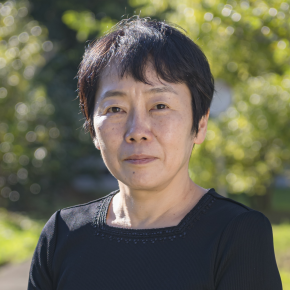The CNRS Institute of Chemistry welcomes Hiroko Yamada as the Ambassador in Chemical Sciences
L’Institut de chimie souhaite la bienvenue à Hiroko Yamada, ambassadeur CNRS des sciences chimiques
On November 13th 2023, Hiroko Yamada will start a series of lectures in several French CNRS laboratories as the Ambassador in Chemical Sciences in France*. As a professor at the Organoelement Chemistry, Institute for Chemical Research (Kyoto University- Japan), Hiroko Yamada‘s research is dedicated to organic electronics and physical organic chemistry. She tells us all about this subject.
- What drove you to go into the field of organic electronics and physical organic chemistry ?
Aromatic compounds such as porphyrins and acenes exhibit a variety of fascinating physicochemical properties: beautiful colours, luminescence, photoexcitation dynamics and electrochemical properties that can be modulated by playing on the electronic structure of the molecules**. However, the synthesis and characterization of pi-extended molecules are often difficult because of the low solubility.
This encouraged me to develop a method for synthesising π-extended organic semiconductors and pigments called the "Precursor Approach". With this approach, the reaction products target aromatic compounds directly during their formation in the form of solvent-insoluble powders. With this process, insoluble aromatic compounds can be easily obtained from the corresponding precursors in solution, in film, or as solid by simple heating or photoirradiation.
I then showed that these precursors could be used to control the crystal structure and orientation of insoluble organic semiconductors to fabricate the active layer of organic electronic devices. By studying the relationship between their molecular structure and electrical conduction, we were able to improve the performance of organic thin-film transistors (OTFTs) and the photovoltaic properties of certain organic molecules (OPVs).
Finally, still using the precursor approach, higher acenes such as nonacene, the unstable acene with nine benzene rings, could be synthesised under ultra-high vacuum on a gold surface and their electronic properties were revealed by scanning tunneling microscopy and non-contact atomic force microscopy. This was possible to study such unstable compounds only by using the precursor approach. These basic results will also be useful for applied research.
** These aromatic compounds are used to manufacture electronic components such as transistors, diodes and sensors.
- What do you think will be the most important development in your field in 5, 10- and 25-years’ time?
Improving the properties of organic electronic devices requires fine control of the aggregation process of organic building blocks or carbon-based nanomaterials during their fabrication. By controlling the aggregation process, it is possible to improve charge mobility, electrical conductivity and device stability. This can lead to enhanced performance, improved energy efficiency and longer lifetimes for devices such as organic transistors, organic light-emitting diodes (OLEDs) and organic solar cells.
For organic semiconductors made up of small molecules, for example, parameters for finely controlling the crystalline structure and molecular orientation in thin films have been suggested in recent years. But we are still far from having explored the immense potential of organic materials chemistry. The close collaboration between organic chemists, device physicists, computer scientists, surface specialists, etc. will lead to new materials with ever better performance thanks to the fine control of this aggregation. This will be one of the most important developments in the near future.
- As a CNRS ambassador of the Chemical Sciences, what are you most looking forward to in your conference tour?
When we reported this "precursor approach" to synthesise new functional materials such as pi-extended porphyrins and higher acenes, we were fortunate to find that researchers from other fields were interested in our compounds and our synthetic approach. We have enjoyed interdeciplinary collaborations with these scientists, in a variety of fields, including organic electronics, surface science, and femto to picosecond spectroscopic science as characterisation tools. These were great and exciting experiences! This lecture tour will enable me to visit eight universities in a fortnight, half of the universities for the first time. I hope this will give me the opportunity to start up new collaborations, thanks to the fruitful discussions that I'm sure to have with my colleagues specialising in other fields such as organic electronics and spintronics...
(*) In 2019, CNRS Institute of Chemistry has initiated a program called “Ambassadors of Chemical Sciences in France”. Its ambition is to give prestigious foreign researchers an opportunity to visit a series of French laboratories active in their field. These visits not only include top-notch conferences by the ambassador, but are also a good opportunity to establish preliminary contacts and foster international collaborations for the visited French laboratories.
Rédacteur : CCdM
Conference tour schedule
Date City Hosting institution & Contact person
13 novembre 2023 Paris Institut parisien de chimie moléculaire (Anna Proust)
14 novembre 2023 Nantes Laboratoire « Chimie et interdisciplinarité, synthèse, analyse, modélisation (Fabrice Odobel)
15 novembre 2023 Angers Laboratoire MOLTECH-Anjou (Sébastien Goeb)
17 novembre 2023 Bordeaux Institut des sciences moléculaires (Dario Bassani)
20 novembre 2023 Toulouse Centre d’Élaboration de Matériaux et d’Etudes Structurales (Claire Kammerer)
21 novembre 2023 Marseille Centre interdisciplinaire de nanoscience de Marseille (Olivier Siri)
22 novembre 2023 Lyon ENS (Christophe Bucher)
24 novembre 2023 Strasbourg Institut de chimie de Strasbourg (Jean Weiss)
